Attracting leafcutter bees to your garden is a great way to boost pollination and support biodiversity. These bees are efficient, solitary pollinators that thrive on certain plants and nesting environments. In this article, you’ll learn about the best leafcutter bee plants to grow, how to create a bee-friendly habitat, and the overall benefits of bees for your garden.
We’ll also discuss how you can support leafcutter bees throughout the year by providing nesting materials and avoiding pesticides. By the end, you’ll know exactly how to attract leaf cutter bees and why they are valuable to your garden’s health.
Why You Should Attract Leafcutter Bees
Leafcutter bees are highly effective pollinators, especially for crops like alfalfa and a variety of fruits and vegetables. Unlike honey bees, they do not swarm and tend to be more solitary in their work. While their habit of cutting leaves may seem destructive, it is a natural behavior that causes minimal harm to plants. These bees use the leaf pieces to create nests, benefiting your garden with improved pollination in return. By learning how to attract leaf cutter bees, you’ll support biodiversity while enhancing your garden’s health.
The Best Leafcutter Bee Plants for Your Garden
To successfully attract leafcutter bees, focus on planting flowers that provide ample nectar and pollen. The best leafcutter bee plants include sunflowers, zinnias, marigolds, and asters. Leafcutter bees are also fond of herbs like lavender, mint, and basil, which offer high-quality pollen. Planting a diverse range of these flowers will ensure that the bees have a continuous food supply throughout the season. Additionally, flowering shrubs such as roses and lilacs are attractive to these bees, as they provide the perfect leaves for nest-building.
Creating a Bee-Friendly Habitat
Leafcutter bees prefer nesting in small cavities, so providing natural or artificial nesting spots is key. You can install bee hotels or leave areas of your garden with hollow plant stems for the bees to use. Leafcutter bees also benefit from easy access to leaves like rose or lilac for building their nests. Avoid using pesticides, as they can harm these beneficial pollinators and disrupt the life cycle of bees. Maintaining a pesticide-free zone will help ensure that the bees thrive in your garden..
Benefits of Attracting Leafcutter Bees
The benefits of bees in your garden go far beyond just pollination. Leafcutter bees are excellent at pollinating flowers that are often overlooked by other pollinators, which helps increase the biodiversity in your garden.
These bees are particularly effective in small gardens and urban environments, where their solitary nature allows them to focus on pollinating nearby plants. By attracting these bees, you’ll enhance crop yields and support the broader ecosystem.
Supporting Leafcutter Bees Throughout the Year
Leafcutter bees are most active during the warmer months, but there are ways to support them year-round. Plant a mix of early-blooming flowers like crocuses and late-bloomers like asters to ensure a steady food source. Providing access to clay or mud can also help these bees seal their nests, offering additional support. If you’re considering how to start a bee farm, understanding the needs of leafcutter bees can be a great first step towards building a thriving pollinator habitat.
Optimize Your Garden with Product From Swarm Commander
By incorporating the right mix of leafcutter bee plants and providing a welcoming habitat, you’ll not only enhance your garden’s productivity but also support these vital pollinators. Whether you’re an avid gardener or just getting started, leafcutter bees can significantly improve pollination and the overall health of your garden.
Want to make your garden even more bee-friendly? Swarm Commander offers innovative products like bee trap attractants and resources for bee hive relocation. Explore how these tools can help manage your garden’s bee populations by visiting Swarm Commander.
Frequently Asked Questions About Attracting Leafcutter Bees
Q1. What are the best plants to attract leafcutter bees?
Leafcutter bees are attracted to plants like sunflowers, zinnias, lavender, basil, and flowering shrubs like roses and lilacs.
.
Q2. How do I create a habitat for leafcutter bees?
Provide nesting spots with hollow plant stems or bee hotels and ensure access to leaves like rose or lilac for nest-building.
Q3. Do leafcutter bees harm plants?
Leafcutter bees cut small sections of leaves for their nests but do not cause significant damage to plants.
Q4. Are leafcutter bees good for vegetable gardens?
Yes, leafcutter bees are efficient pollinators for crops like tomatoes, peppers, and beans, enhancing yields in vegetable gardens..
Q5. How can I support leafcutter bees year-round?
Plant a variety of flowers that bloom in succession, provide access to clay for nest-sealing, and maintain a pesticide-free environment.



